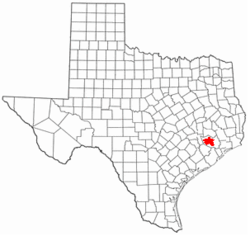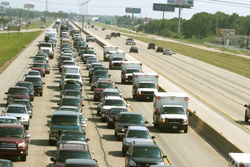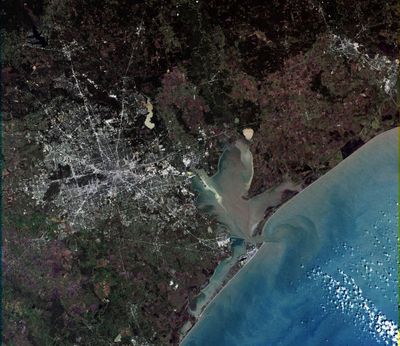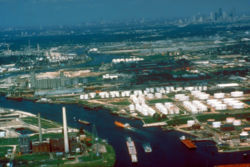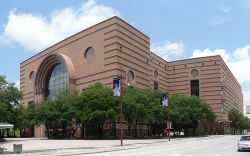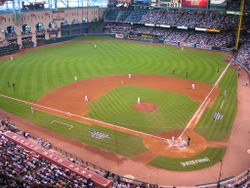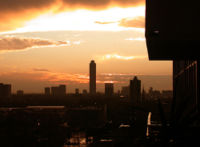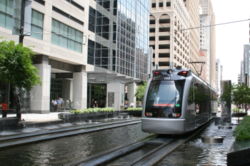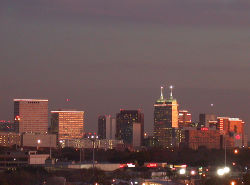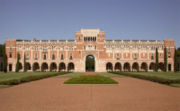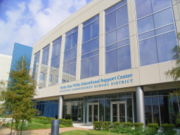Houston, Texas
2007 Schools Wikipedia Selection. Related subjects: North American Geography
| Houston, Texas | |||||
 |
|||||
|
|||||
| Nickname: "Bayou City" | |||||
| Location in the state of Texas | |||||
| Coordinates: | |||||
|---|---|---|---|---|---|
| Counties | Harris County Fort Bend County Montgomery County |
||||
| Mayor | Bill White | ||||
| Area | |||||
| - City | 1,558 km² (601.7 sq mi) | ||||
| - Land | 1,501 km² (579.4 sq mi) | ||||
| - Water | 57.7 km² (22.3 sq mi) | ||||
| Elevation | 13 m (43 ft) | ||||
| Population | |||||
| - City (2005) | 2,016,582 | ||||
| - Density | 521.1/km² (1,349.6/sq mi) | ||||
| - Urban | 4,283,000 | ||||
| - Metro | 5,280,077 | ||||
| Time zone | CST ( UTC-6) | ||||
| - Summer ( DST) | CDT ( UTC-5) | ||||
| Website: www.houstontx.gov | |||||
Houston ( pronounced [hju:stən]) is the largest city in the state of Texas and the fourth-largest in the United States. The city covers more than 600 square miles (1,600 km²) and is the county seat of Harris County—the third-most populous in the country. As of the 2005 U.S. Census estimate, Houston had a population of more than 2 million. The city is at the heart of the Houston–Sugar Land–Baytown metropolitan area, the largest cultural and economic centre of the Gulf Coast region and the seventh-largest metropolitan area in the U.S. with a population of 5.3 million in 10 counties.
Houston is internationally known for its energy (particularly oil) and aeronautics industries, and for its ship channel. The Port of Houston ranks first in the country in international commerce and is the sixth-largest port in the world. Second only to New York City in Fortune 500 headquarters, Houston is the seat of the Texas Medical Centre, which contains the world's largest concentration of research and healthcare institutions.
Houston is ranked as one of 11 U.S. world-class cities by the Globalization and World Cities Study Group & Network. The city has an active visual and performing arts scene as Houston is one of the five U.S. cities that offer year-round resident companies in all major performing arts. In addition, the Houston Theatre District is ranked second in the country for the number of theatre seats in a concentrated downtown area per capita. The city is within proximity to beaches on Galveston Island.
History
Early settlers
In August 1836, two brothers— John Kirby Allen and Augustus Chapman Allen—who were New York real estate promoters purchased 6,642 acres (27 km²) of land from T. F. L. Parrot, John Austin's widow, for $9,428. The Allen brothers named their town after Sam Houston. Thomas H. and Gail Borden surveyed and mapped the town in typical grid fashion, with wide streets running parallel and perpendicular to the area's system of bayous. The city was granted incorporation on June 5, 1837 and James S. Holman became the first mayor. That same year, Houston also became the county seat of Harrisburg County, which was renamed Harris County in 1839. At this time, the Texas Legislature designated Houston as the temporary capital of the new Republic of Texas. The capital was later moved to Austin, then known as Waterloo, on January 14, 1839.
Lawlessness, epidemics, and financial problems prompted the people of the community to establish a Chamber of Commerce, chartered by the Congress of the Republic on November 26, 1838. Because many of the first settlers were from the South, Houston endorsed the slavery- plantation system. Slaves lived scattered through the neighborhoods, though there were a few free blacks in the city.
By 1860, Houston emerged as a commercial and railroad hub for the export of cotton. Railroad spurs from the Texas inland converged in Houston, where they met rail lines to the ports of Galveston and Beaumont. During the Civil War, Houston served as a headquarters for General John Bankhead Magruder, who used Houston as an organization point for the Battle of Galveston. Houston saloon keeper Dick Dowling became the city's first famous personality after his victory at the battle of Sabine Pass in 1863. After the Civil War, Houston businessmen initiated efforts to widen the city's extensive system of bayous so the city could accept more commerce between downtown and the nearby port of Galveston.
Early 20th century
Oil discovery at Spindletop in Beaumont in 1901 prompted the development of the oil industry, which eventually would transform Houston into a large city. In 1902, Theodore Roosevelt approved a $1 million improvement project for the Houston Ship Channel. By 1910, the population of Houston was larger than that of Galveston. President Woodrow Wilson opened the Port of Houston in 1914, 74 years after digging started. By 1914, the Houston Ship Channel was dredged to give Houston a deep-water port, outpacing Galveston's port which was devastated by the Galveston Hurricane of 1900.
By the end of the 1930s, Houston began having growing pains—the city was no longer a frontier town, and its air service was inadequate for its needs. By 1939, Houston was Texas's most populous city.
When World War II started, tonnage levels fell and five shipping lines ended service to Houston, but the war did have some economic benefits for the city. Ellington Field, initially built during World War I, was revitalized as a training centre for bombardiers, and aircraft and shipbuilding became large industries statewide. The M. D. Anderson Foundation formed the Texas Medical Centre in 1945. After the war, Houston's economy reverted back to a healthy, port driven economy. In 1948, several unincorporated areas were annexed into the city limits, and Houston proper began to spread across the prairie.
Decades of growth

Shipbuilding during World War II spurred Houston's growth, as well as the establishment in 1961 of NASA's "Manned Spacecraft Centre" (renamed the Lyndon B. Johnson Space Centre in 1973), which created the city's aerospace industry. The Astrodome (then called the Harris County Domed Stadium), the first indoor, domed sports stadium, opened in 1965 and was quickly nicknamed the "Eighth Wonder of the World."
During the late 1970s, Houston experienced a population boom as people from Rust Belt states moved en masse into Texas, which benefited from the Arab Oil Embargo. Because of Houston's over-reliance on petroleum as the base of its industry, the local economy suffered and the population boom abruptly ended when oil prices fell in 1986 due to the embargo being lifted. The space industry also suffered in 1986 with the Space Shuttle Challenger disaster. The late 1980s saw a recession for the Houston economy. Since this recession, Houston has made efforts to diversify its economy by focusing on aerospace and biotechnology, and reducing its dependence on petroleum. In 1990, the G7 Summit was held in Houston.
The new millennium
In 2001, Tropical Storm Allison dumped up to 39 inches of rain on parts of the city, causing billions of dollars in damage and killing 43 people. To date, the flooding caused by Allison was the worst in the city's history. Many neighborhoods and communities have changed since the storm; older houses in some affected neighborhoods have been torn down and replaced with larger houses with higher foundations.
In December 2001, Houston-based energy company Enron collapsed into the second-largest ever U.S. bankruptcy during an investigation surrounding fabricated partnerships that were allegedly used to hide debt and inflate profits.
In the wake of Hurricane Katrina in August 2005, Houston provided shelter to more than 150,000 people from New Orleans in various facilities around the city, including about 24,000 who were sheltered in the infrequently-used Reliant Astrodome stadium. This unprecedented situation involved Houston-area public school systems, which provided education for child evacuees.
Approximately 2.5 million Houston area residents evacuated when Hurricane Rita approached the Gulf Coast one month after Hurricane Katrina. Hurricane Rita left little damage to Houston and the surrounding areas. Critical traffic congestion and gas shortages were rampant during the evacuation. This event marked the largest evacuation in the history of the United States.
Geography
According to the United States Census Bureau, the city has a total area of 601.7 square miles (1,558.4 km²) — 579.4 square miles (1,500.7 km²) of it is land and 22.3 square miles (57.7 km²) of it is water. The total area is 3.7 percent water.
Most of Houston is located in the gulf coastal biome plains, and its vegetation is classified as temperate grassland and forest. Much of the city was built on forested land, marshes, swamp, or prairie—all of which can still be seen in surrounding areas.
Much of Houston is very flat, making flooding a recurring problem for its residents. Downtown stands about 50 feet (15 m) above sea level—with most of the city less than 100 feet (30 m) in elevation. The city once relied on groundwater for its water needs, but land subsidence forced the city to turn to ground-level water sources such as Lake Houston and Lake Conroe.
Houston has four major bayous passing through the city: Buffalo Bayou, which runs into downtown and the Houston Ship Channel; and three of its tributaries: Brays Bayou, which runs along the Texas Medical Centre; White Oak Bayou, which runs through the Heights and near the northwest area; and Sims Bayou, which runs through the south of Houston and downtown Houston. The ship channel goes past Galveston and into the Gulf of Mexico.
Geology
Underpinning Houston's land surface are unconsolidated clays, clay shales, and poorly-cemented sands up to several miles deep. The region's geology developed from stream deposits formed from the erosion of the Rocky Mountains. These sediments consist of a series of sands and clays deposited on decaying organic matter that, over time, transformed into oil and natural gas. Beneath these tiers is a water-deposited layer of halite, a rock salt. The porous layers were compressed over time and forced upward. As it pushed upward, the salt dragged surrounding sediments into dome shapes, often trapping oil and gas that seeped from the surrounding porous sands. This thick rich soil also provides a good environment for rice farming in suburban outskirts that the city continues to grow into near Katy. Evidence of past rice farming is even still evident in developed areas as there is an abundance of rich dark loamy top soil.
The Houston region is generally earthquake-free. While the city of Houston contains over 150 active surface faults (some have estimated as many as 300 active faults) with an aggregate length of up to 310 miles (500 km), the clay below the surface precludes the buildup of friction that produces ground shaking in earthquakes. These faults generally move at a smooth rate in what is termed "fault creep."
Cityscape
When Houston was established in 1837, the city's founders— John Kirby Allen and Augustus Chapman Allen—divided it into political geographic districts called " wards." The ward designation is the progenitor of the current-day Houston City Council districts—there are nine in all.
Locations in Houston are generally classified as either being inside or outside Interstate 610, known as the "610 Loop" or "the Loop." Inside the loop encompasses the central business district and many residential neighborhoods that pre-date World War II. More recently, new higher-density residential development has resulted in an urban lifestyle and state of mind. The appellation “inner loop Houston” carries with it the expectations of cosmopolitan-style city life.
The outlying areas of Houston, the airports and the city's suburbs and enclaves are outside the loop. Another ring road, State Highway Beltway 8 (also known simply as the "Beltway"), encircles the city another 5 miles (8 km) farther out. The third ring road, State Highway 99 (also known as the Grand Parkway), is under construction.
Houston, being the largest city in the United States without zoning laws, has grown in an unusual manner. Rather than a single " downtown" as the centre of the city's employment, five additional business districts have grown throughout the city—they are Uptown, Texas Medical Centre, Greenway Plaza, Westchase, and Greenspoint. If these business districts were combined, they would form the third-largest downtown in the United States.
Climate
Houston's climate is classified as humid subtropical (Cfa in Köppen climate classification system). The city has excessive ozone levels and is ranked among the most ozone-polluted cities in the United States. The average yearly precipitation level is approximately 48 inches (1,220 mm). Spring supercell thunderstorms sometimes bring tornadoes to the area. Prevailing winds are from the south and southeast during most of the year, bringing heat from the deserts of Mexico and moisture from the Gulf of Mexico.
During the summer months, the daily high temperature peaks at 94 °F (34 °C) at the end of July with an average of 99 days per year above 90 °F (32 °C). The air tends to feel still and the humidity (averaging over 90 percent relative humidity in the morning in the summer and around 60 percent in the afternoon) results in a heat index higher than the actual temperature. To cope with the heat, people use air conditioning in nearly every car and building in the city. Afternoon rains are common and for most summer days, Houston meteorologists predict at least some chance of rain. The hottest temperature ever recorded in Houston was 109 °F (43 °C) on September 4, 2000.
Winters in Houston are cool and temperate. While the average high in January, the coldest month, is 61 °F (16 °C), Houston sees an average of 18 days per year of 32 °F (0 °C) or less. Snowfall is rare, and typically does not accumulate when it is seen. The last snowstorm to hit Houston was on December 24, 2004—the city's first recorded snowfall on Christmas Eve. The coldest temperature ever recorded in Houston was 5 °F (−15 °C) on January 23, 1940.
| Month | Jan | Feb | Mar | Apr | May | Jun | Jul | Aug | Sep | Oct | Nov | Dec | Year |
|---|---|---|---|---|---|---|---|---|---|---|---|---|---|
| Average high °F (°C) | 61 (16) | 66 (18) | 73 (22) | 79 (26) | 85 (29) | 91 (32) | 94 (34) | 93 (33) | 89 (31) | 82 (27) | 72 (22) | 65 (18) | 79 (26) |
| Average low °F (°C) | 41 (5) | 44 (6) | 51 (10) | 58 (14) | 65 (18) | 71 (21) | 73 (22) | 73 (22) | 68 (20) | 59 (15) | 50 (10) | 44 (6) | 58 (14) |
| Average precipitation: inches (mm) |
3.9 (99) | 2.9 (74) | 3.5 (89) | 3.6 (91) | 5.6 (142) | 5.1 (129) | 3.4 (86) | 3.7 (94) | 4.3 (109) | 4.7 (119) | 3.7 (94) | 3.6 (91) | 47.9 (1217) |
| Source: Weatherbase | |||||||||||||
Government and politics
Founded in 1836 and incorporated in 1837, Houston is one of the fastest growing major cities in the United States and the largest without strict zoning laws. The city is the county seat of Harris County. A portion of southwest Houston extends into Fort Bend County and a small portion in the northeast extends into Montgomery County.
The city of Houston has a strong mayor-council government. The City's elected officials, serving concurrent two year terms, are: the mayor, the city controller and 14 members of the city council. Under the strong mayor-council government, the mayor serves as the executive officer of the city. As the city's chief administrator and official representative, the mayor is responsible for the general management of the city and for seeing that all laws and ordinances are enforced.
As of 2006, the mayor of Houston is Bill White, who is serving his second term. City council members are elected from nine districts in the city, along with five at-large positions. At-large council members represent the entire city. The current city council lineup was based on a U.S. Justice Department mandate which took effect in 1979. Houston is a home rule city and all municipal elections in the state of Texas are nonpartisan.
Many local lawmakers have been impacted by the city's term limits. Several former city officials—Anthony Hall, Rodney Ellis, Sheila Jackson Lee, Sylvia Garcia, Martha Wong, Chris Bell, and Annise Parker—had to run for another elected position once their term expired.
Former mayor Lee P. Brown denounced the term limits, saying they prevented incumbents from gaining enough experience in city government. A proposal to double the current two-year term of office has been debated—as of 2005, several candidates for the city council have brought up the issue of whether term limits should be amended or eliminated.
Some elected officials from the Greater Houston area within the Texas Legislature—primarily Garnet Coleman and Sylvester Turner—have also spoken against term limits.
Houston is best considered to be a politically divided city whose balance of power often sways between Republicans and Democrats. The affluent western-central portions of Houston—such as River Oaks and the Memorial/Spring Branch area—consistently vote Republican, while many of the inner city neighbohoods are heavily Democrats. According to the 2005 Houston Area Survey, 67 percent of non-Hispanic whites in the city are declared or favour Republicans while 88 percent of non-Hispanic blacks in the city are declared or favour Democrats. About 58 percent Hispanics (of any race) in the city are declared or favour Democrats. The master-planned communities of Kingwood and Clear Lake City in the northeast and southeast portions of the city, respectively, are heavily Republican.
Economy
Houston ranks second in employment growth rate and fourth in nominal employment growth among the 10 most populous metro areas. In 2006, the Houston metropolitan area ranked first in Texas and third in the U.S. within the category of "Best Places for Business and Careers" by Forbes.
Houston's energy industry is recognized worldwide (particularly oil), but biomedical research, aeronautics, and the ship channel are also large parts of the city's industrial base. The area is also the world's leading centre for building oilfield equipment. Much of Houston's success as a petrochemical complex is due to its busy man-made ship channel, the Port of Houston. The port ranks first in the country in international commerce and is the sixth-largest port in the world. Unlike most places, where high gas prices are seen as harmful to the economy, they are generally seen as beneficial for Houston as many are employed in the energy industry.
The Houston–Sugar Land–Baytown MSA's Gross Area Product (GAP) in 2005 was $308.7 billion, up 5.4 percent from 2004 in constant dollars—slightly larger than Austria's Gross Domestic Product ( GDP). Only 28 nations other than the United States have a GDP exceeding Houston's GAP. Mining, which in Houston is almost entirely oil and gas exploration and production, accounts for 11 percent of Houston's GAP—down from 21 percent as recently as 1985. The reduced role of oil and gas in Houston's GAP reflects the rapid growth of other sectors—such as engineering services, health services, and manufacturing.
Forty foreign governments maintain trade and commercial offices here and the city has 23 active foreign chambers of commerce and trade associations. Twenty foreign banks representing 10 nations operate in Houston and provide financial assistance to the international community.
Demographics
| City of Houston Past censuses |
||
| Year | Population | Rank |
|---|---|---|
| 1850 | 2,396 | |
| 1860 | 4,845 | |
| 1870 | 9,332 | |
| 1880 | 16,513 | |
| 1890 | 27,557 | |
| 1900 | 44,633 | 85 |
| 1910 | 78,800 | 68 |
| 1920 | 138,276 | 45 |
| 1930 | 292,352 | 26 |
| 1940 | 384,514 | 21 |
| 1950 | 596,163 | 14 |
| 1960 | 938,219 | 7 |
| 1970 | 1,232,802 | 6 |
| 1980 | 1,595,138 | 5 |
| 1990 | 1,630,553 | 4 |
| 2000 | 1,953,631 | 4 |
As of the census GR2 of 2000, there were 1,953,631 people, 717,945 households, and 457,330 families residing in the city. The population density was 3,371.7 people per square mile (1,301.8/km²). There were 782,009 housing units at an average density of 1,349.6 per square mile (521.1/km²). If the city of Houston were a U.S. state, it would rank 36th in population—its 2.01 million residents in 2004 would place it behind Nevada and ahead of New Mexico.
There were 717,945 households out of which 33.1 percent had children under the age of 18 living with them, 43.2 percent were married couples living together, 15.3 percent had a female householder with no husband present, and 36.3 percent were non-families. Twenty-nine percent of all households were made up of individuals and 6.2 percent had someone living alone who was 65 years of age or older. The average household size was 2.67 and the average family size was 3.39.
In the city, the population was spread out with 27.5 percent under the age of 18, 11.2 percent from 18 to 24, 33.8 percent from 25 to 44, 19.1 percent from 45 to 64, and 8.4 percent who were 65 years of age or older. The median age was 31 years. For every 100 females there were 99.7 males. For every 100 females age 18 and over, there were 97.8 males.
The median income for a household in the city was $36,616, and the median income for a family was $40,443. Males had a median income of $32,084 versus $27,371 for females. The per capita income for the city was $20,101. Nineteen percent of the population and 16 percent of families were below the poverty line. Out of the total population, 26.1 percent of those under the age of 18 and 14.3 percent of those 65 and older were living below the poverty line.
Race and ethnic origins
Houston is a diverse and international city, in part because of its many academic institutions and strong biomedical, energy, manufacturing and aerospace industries. According to the U.S. Census 2000, the racial makeup of the city was 49.27 percent White, 25.31 percent Black or African American, 0.44 percent Native American, 5.31 percent Asian, 0.06 percent Pacific Islander, 16.46 percent from other races, and 3.15 percent from two or more races. Thirty-seven percent of the population was Hispanic or Latino of any race.
The Hispanic population in Houston is increasing as more immigrants (illegal or otherwise) from Latin American countries look for work in Houston. The city has the third-largest Hispanic population in the United States. It is estimated that about 400,000 immigrants reside in the Houston area illegally. This influx of immigrants is partially responsible for Houston having a population younger than the national average.
Houston also has large populations of immigrants from Asia. In addition, the city has the largest Vietnamese American population in Texas and third-largest in the United States.
Crime
Houston recorded 336 murders in 2005, in comparison to 272 in 2004. This means that it had a murder rate of 17 murders per year for every 100,000 people, which was roughly the same as that of France. Despite the rise in homicides of 23.5 percent, overall crime in the city dropped by 2 percent in 2005 compared to 2004. Most of the homicides that occurred in the last quarter of 2005 occurred in the city's apartment complexes—primarily in the southwest and north-central areas of Houston. So far, Houston is on pace for over 400 murders by the end of 2006.
At one time Houston was the murder capital of the United States in 1982 when it recorded 702 homicides. In years since, the city had at least an average of 600-plus murders throughout the 1980s, until it finally had less than 300 murders on average every year since 1995.
Houston is, as of 2006, going through a spike in crime due in part to an influx of people from New Orleans into the city following Hurricane Katrina. These hurricane victims seeking refuge are believed to have been involved in nearly 17 percent of all homicides. Houston's murder rate increased 70 percent in November and December of 2005 compared to 2004's levels. At least 35 percent of the city's December 2005 increase in homicides—five of 14 over last year’s level—have been directly attributed to the presence of hurricane victims from New Orleans.
Culture
Officially, Houston is nicknamed the "Space City" as it is home to NASA's Lyndon B. Johnson Space Centre, where Mission Control Centre is located. Because of this, "Houston" was the first word spoken on the moon. Many locals, however, prefer to call it the "Bayou City." Other nicknames include "H-Town," "Clutch City," and "Magnolia City".
About 90 languages are frequently spoken in the Houston area. Some neighborhoods with high populations of Vietnamese and Chinese residents have Chinese and Vietnamese street signs in addition to English ones. Houston has two Chinatowns—the original located in Downtown and the more recent one developed is along Bellaire Boulevard in the southwest area of the city. The city also has a Little Saigon in Midtown and Vietnamese businesses located in the southwest Houston Chinatown.
There are many popular events held in the city celebrating cultures of Houstonians. The largest and longest running is the annual Houston Livestock Show and Rodeo that is held over 20 days from late February through early March. The event begins with trail rides that originate from several points throughout the state, all of which convene at Reliant Park for a barbeque cook-off. The rodeo includes typical rodeo events, as well as concert performances from major artists and carnival rides. Another large celebration is the annual night-time Houston Pride Parade held at the end of June held along Westheimer Road in Neartown—home to many 1950s-style restaurants, vintage shops, tattoo parlors, bars, nightclubs, coffeehouses, and gay entertainment. Other events held annually include the Houston Greek festival, Art Car Parade, and Houston International Festival.
Arts and theatre
Having an active visual and performing arts scene, Houston's Theatre District has the second largest number of theatre seats in a concentrated downtown area in the United States, with 12,948 seats for live performances and 1,480 movie seats. The Theater District is located in the centre of downtown and is home to nine of Houston's performing arts organizations and six performance halls. Houston is one of only five cities in the United States with permanent professional resident companies in all of the major performing arts disciplines: opera ( Houston Grand Opera), ballet ( Houston Ballet), music ( Houston Symphony Orchestra), and theatre ( The Alley Theatre). In addition to its visual and performing arts organizations, the city is host to local folk art such as its art cars. Houston is recognized as an important city for contemporary visual arts. The city is a prime stop for touring companies from Broadway, concerts, shows, and exhibitions for a variety of interests, ranging from the nation's largest quilting show to auto, boat, home, and gun shows.
Adjacent to the Texas Medical Centre is the Museum District, which is home to most of the city's major museums: The Museum of Fine Arts, Houston, the Contemporary Arts Museum Houston, the Cullen Sculpture Garden, the Houston Museum of Natural Science, the Holocaust Museum Houston, the Children's Museum of Houston, Lawndale Art Centre, the Houston Zoo, and the John P. McGovern Museum of Health & Medical Science. Located in the nearby Montrose area are The Menil Collection and Rothko Chapel. Approximately 4 million people visit institutions in the Museum District every year.
Tourism and recreation
Space Centre Houston is the official visitors’ centre of NASA's Lyndon B. Johnson Space Centre. Space Centre Houston includes many interactive exhibits—including moon rocks and a shuttle simulator—in addition to special presentations that tell the story of NASA's manned space flight program. It also features Texas’s largest IMAX theatre.
The Theatre District—a 17-block area in the centre of downtown Houston—is home to Bayou Place Entertainment Complex, restaurants, movies, plazas, and parks. Bayou Place is a large multilevel building that is home to full service restaurants, bars, live music, billiards and art house films. The Houston Verizon Wireless Theatre stages a variety of live concerts, stage plays, and stand up comedy; and the Angelika Theatre presents the latest in art, foreign and independent films.
Houston is home to many parks including Hermann Park—houses the Houston Zoo and the Houston Museum of Natural Science—Lake Houston Park, Memorial Park, and Sam Houston Park. Additionally, Houston has 337 city parks and over 200 greenspaces—totaling over 19,600 acres that are managed by the city—including the Houston Arboretum and Nature Centre. What was once the Houston Civic Centre was replaced by the George R. Brown Convention Centermdash;one of the nation's largest—and the Jesse H. Jones Hall for the Performing Arts, home of the Houston Symphony Orchestra and Society for the Performing Arts. The Sam Houston Coliseum and Music Hall have been replaced by the Hobby Centre for the Performing Arts.
Other tourist attractions include the Galleria, Texas's largest shopping mall located in the Uptown District, Old Market Square, Tranquility Park, the Downtown Aquarium, and Sam Houston Historical Park, which contains restored homes (built between 1824 and 1868) and reconstructed buildings. The San Jacinto Battlefield is in the nearby city of Deer Park.
Sports
Houston has hosted recent, major sporting events, including the 2004 Major League Baseball All-Star Game, Super Bowl XXXVIII, the 2005 World Series, the 2005 Big 12 Conference football championship game, the 2006 NBA All-Star Game, the U.S. Men's Clay Court Championships from 2001-2006, and the Tennis Masters Cup in 2003 and 2004, as well as the annual Shell Houston Open. The city hosts the annual the NCAA College Baseball Minute Maid Classic every February and NCAA football's Texas Bowl in December.
Houston has teams in nearly every major professional sport including: Houston Astros ( MLB), Houston Texans ( NFL), Houston Rockets ( NBA), Houston Comets ( WNBA), Houston Aeros ( AHL), Houston Undertakers ( ABA) and Houston Dynamo ( MLS). The Houston Astros advanced to the World Series for the first time in the team's history on October 19, 2005; however, they subsequently lost to the Chicago White Sox. In addition, the Houston Dynamo won the MLS Cup in their first year after moving from San Jose.
Minute Maid Park (home of the Astros) and Toyota Centre (home of the Rockets, Comets, and Aeros) are located in downtown—contributing to an urban renaissance that has transformed Houston's centre into a day-and-night destination. Also, the city has the first domed stadium in the United States and also holds the NFL's first retractable roof stadium— Reliant Stadium. Other sports facilities in Houston are Hofheinz Pavilion, Reliant Astrodome, Robertson Stadium, and Rice Stadium. The infrequently-used Reliant Astrodome hosted World Wrestling Entertainment's WrestleMania X-Seven on April 1, 2001, where an attendance record of 67,925 was set.
In early 2006, the Champ Car auto racing series returned to Houston for a yearly race, held on the streets of the Reliant Park complex. The city had previously been home to a Champ Car round from 1998 to 2001.
Architecture
Houston's skyline has been ranked fourth-most impressive in the United States when ranked primarily by height, being the country's third-tallest skyline (after Chicago and New York City) and one of the top ten in the world; however, because it is spread over a few miles, most pictures of the city show only the main downtown area.
Downtown
In the 1960s, Downtown Houston comprised of a modest collection of mid-rise office structures, but has since grown into one of the largest skylines in the United States. In 1960, the central business district had 10 million square feet (1,000,000 m²) of office space, increasing to about 16 million square feet (1,600,000 m²) in 1970. Downtown Houston was on the threshold of a boom in 1970 with 8.7 million square feet (870,000 m²) of office space planned or under construction and huge projects being launched by real estate developers. Houston experienced another downtown construction spurt in the 1970s with the energy industry boom. A succession of skyscrapers were built throughout the 1970s—many by real estate developer Gerald D. Hines—culminating with Houston's tallest skyscraper, the 75-floor, 1,002-foot-tall (305 m) JPMorgan Chase Tower (formerly the Texas Commerce Tower), which was completed in 1982. It is the tallest structure in Texas, ninth-tallest building in the United States and the 29th-tallest skyscraper in the world. In 1983, the 71-floor, 970-foot-tall (296 m) Wells Fargo Bank Plaza was completed, which became the second-tallest building in Houston and Texas, and 11th-tallest in the country. As of December 2001, downtown Houston had about 40 million square feet (4,000,000 m²) of office space, including 28 million square feet (2,800,000 m²) of class A office space.
In addition, many buildings in downtown are linked by a system of tunnels and skywalks. The tunnel system also includes shops, restaurants, and convenience stores.
Uptown
The Uptown District is mainly centered around Post Oak Boulevard and the Galleria. The district boomed during the 1970s and early 1980s when a collection of mid-rise office buildings, hotels, and retail developments appeared along Interstate 610 west. Uptown became one of the most impressive instances of an edge city. The highest achievement of Uptown was the construction of the 899-foot-tall (274 m), Philip Johnson and John Burgee designed landmark Williams Tower (known as the Transco Tower until 1999). At the time, it was believed to the be the world's tallest skyscraper outside of a central business district.
The Uptown District is also home to other buildings designed by noted architects such as I. M. Pei and César Pelli among others also designed by Philip Johnson. The district had 23.8 million square feet (2,210,000 m²) of office space in 2001—Downtown had about 40 million square feet (4,000,000 m²). In the late 1990s, there was a mini-boom of mid-rise residential tower construction, typically about 30 stories tall. Uptown has accumulated a large concentration of high-rise residential structures for such a low-density city.
Transportation
Highways
Houston’s freeway system includes 575.5 miles of freeways and expressways in the 10-county metro area. Its highway system has a hub-and-spoke freeway structure with multiple loops. The innermost is Interstate 610, forming approximately a 10 mile diameter loop around downtown. The roads of Beltway 8 and their freeway core, the Sam Houston Tollway, are the next loop, at a diameter of roughly 25 miles. A proposed highway project, State Highway 99 (The Grand Parkway), would form a third loop outside of Houston. Currently, the completed portion of State Highway 99 runs from just north of Interstate 10, west of Houston, to U.S. Highway 59 in Sugar Land, southwest of Houston, and was completed in 1994.
Houston also lies along the route of the proposed Interstate 69 NAFTA superhighway that will link Canada, the U.S. industrial Midwest, Texas, and Mexico.
Mass transit
The Metropolitan Transit Authority of Harris County, Texas, or METRO, provides public transportation in the form of buses, light rail, trolleys, and lift vans. METRO's various forms of public transportation still do not connect many of the suburbs to the greater city, causing Houstonians to rely on the automobile as a primary source of transportation.
METRO began running light rail service ( METRORail) on January 1, 2004. Currently the track is rather short—it runs about 8 miles (13 km) from northern Downtown at UH–Downtown to the Texas Medical Centre and Reliant Park. Prior to the opening of METRORail, Houston was the largest city in the United States devoid of a rail transit system by a very large margin. That title has since been passed to Phoenix. METRO is currently in the beginning design phases of a 10-year expansion plan to add five more sections to connect to the current light rail system.
Airports
Houston is served by two commercial airports—the largest of which is the George Bush Intercontinental Airport (IAH). The airport is the ninth-busiest in the United States for total passengers, and 19th busiest worldwide. Houston is the headquarters of Continental Airlines, Bush Intercontinental is Continental Airlines' largest hub. The airline alone offers more than 750 daily departures
Bush Intercontinental currently ranks third in the United States for non-stop domestic and international service with 182 destinations. This trails O'Hare International Airport with 192 destinations and Atlanta Hartsfield with 239 destinations. The United States Department of Transportation has also recently named George Bush Intercontinental Airport one of the top 10 fastest growing airports in the United States.
The second-largest commercial airport in Houston is William P. Hobby Airport (named Houston International Airport until 1967). The airport operates primarily small to medium-haul flights and is the only airport in Houston served by Southwest Airlines and JetBlue Airways. Business travelers on shorter routes to Houston from within the United States tend to prefer Hobby over Bush Intercontinental.
The third-largest airport and former U.S. Air Force base, Ellington Field, is primarily used for government and private aircraft. At one point, Continental Express operated flights across the city to Bush Intercontinental primarily for residents of southeast Houston and Galveston County. Passenger flights, however, ended on September 7, 2004.
The Federal Aviation Administration and the state of Texas selected the "Houston Airport System as Airport of the Year" for 2005, largely because of its multi-year, $3.1 billion airport improvement program for both major airports in Houston.
Education and research
Healthcare and scientific research
Houston is the seat of the internationally-renowned Texas Medical Centre, which contains the world's largest concentration of research and healthcare institutions.
There are 42 member institutions in the Texas Medical Centre—all are not-for-profit— providing patient and preventive care, research, education, and local, national, and international community well-being. These institutions include 13 renowned hospitals and two specialty institutions, two medical schools, four nursing schools, and schools of dentistry, public health, pharmacy, and virtually all health-related careers. It is where one of the first—and still the largest—air emergency service was created, a very successful inter-institutional transplant program was developed. In addition, more heart surgeries are performed at the Texas Medical Centre than anywhere else in the world.
Some of the academic and research health institutions are Baylor College of Medicine, The University of Texas Health Science Centre at Houston, The Methodist Hospital, and The University of Texas M. D. Anderson Cancer Centre. The M. D. Anderson Cancer Centre is widely considered one of the world's most productive and highly-regarded academic institutions devoted to cancer patient care, research, education and prevention.
Higher education
Houston has the University of Houston System, which is the largest urban state system of higher education in the Gulf Coast with over 56,000 students. The system has three independent and self-governing universities located in within the city: University of Houston, UH–Clear Lake, and UH–Downtown. UH System's flagship institution is the University of Houston (UH) and it is the only doctoral degree granting comprehensive research institution in East Texas. Its flagship UH campus is the third-largest university in Texas with an enrollment of more than 35,000 and is home to more than 40 research centers and institutes. In addition to UH System institutions, the city has Texas Southern University, a historically black university located in the historic Third Ward community.
Houston is the location of several private institutions—both secular and non-secular. The city is home to Rice University, a private institution boasting one of the largest financial endowments of any university in the world—it was ranked the 17th-best university overall in the nation by U.S. News & World Report. Rice maintains a variety of research facilities and laboratories. Founded in 1923, South Texas College of Law boasts one of the nation's finest programs for trial advocacy and is Houston's oldest law school. The University of St. Thomas, a Catholic liberal arts college following the Basilian tradition, was founded by the Basilian fathers of Canada, and located in the Montrose area. Houston Baptist University, a Baptist institution founded in 1960, is located in southwest Houston and boasts more than 50 undergraduate majors and pre-professional programs ranging from Biblical languages to nursing.
Much of Houston is served by the Houston Community College System, which is the fourth largest community college systems in the United States. Parts of northern Houston are served by North Harris Montgomery Community College District. Parts of eastern and southeastern Houston are served by San Jacinto College.
Primary and secondary education
All public school systems in Texas are administered by the Texas Education Agency (TEA). There are many public school districts serving the city of Houston—the largest of which is the Houston Independent School District, which serves a large majority of the area within the city. There are 15 other school districts that also take students from the city limits.
There are also many charter schools that are run separately from school districts, but are administered by the Texas Education Agency. In addition, public school districts—such as Houston ISD and Spring Branch ISD—also have their own charter schools.
Houston has numerous private schools of all types. The Texas Education Agency has no authority over private school operations; private schools may or may not be accredited, and achievement tests are not required for private school graduating seniors. The Houston area is home to more than 300 private schools and several are well-known. Many of the schools are accredited by an accrediting agency recognized by Texas Private School Accreditation Commission (TEPSAC). In addition, Houston area Catholic schools are operated by the Archdiocese of Galveston-Houston.

